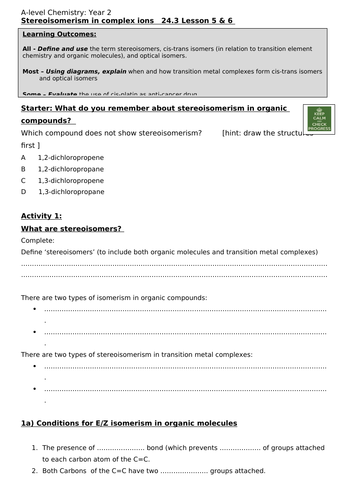


Student workbook and teacher PP for OCR A Level Chemistry A Year 2 Chapter 24.3 Stereoisomerism in complex ions. The material covered could be used over two lessons (Lesson 1- cis and trans isomers and Lesson 2- Optical isomers), depending on time available.
There is a short review of the conditions for E-Z and cis -trans isomerism in organic molecules and next, cis-trans isomerism is explored in square planar and in octahedral complexes (with six monodentate ligands and in complexes with two bidentate and two monodentate ligands). Optical isomerism is explored in octahedral complexes (with three bidentate ligands and in complexes with two bidentate and two monodentate ligands). The key terms associated with this topic, such as: complex ion, stereoisomers, optical isomers, octahedral shape, square planar, monodentate ligand, bidentate ligand and many more are used extensively.
Students are given plenty of application tasks to assess their knowledge. There are many opportunities for student to practise using the wages to represent 3D structures of different isomers.
The resources can be used in class, or by students themselves (e.g. if they are not in the lesson).
Teacher PP supports Student workbook and contains answers to all questions. The answers are revealed in steps when working through questions.
I have just updated this resource to include more recent exam questions.
The resource was prepared with the use of A Level Chemistry for OCR A textbooks.
Some diagrams and some questions were taken from this book.
Get this resource as part of a bundle and save up to 37%
A bundle is a package of resources grouped together to teach a particular topic, or a series of lessons, in one place.
Something went wrong, please try again later.
For £8.00 this resource should have been more than 2 copies of the same powerpoint! The content is fine - though like you said, straight from the book. <br /> <br /> However the student ppt is just a copy of the teacher powerpoint with blanks!! <br /> <br /> Considering you were making OCR A resources I really wanted this to be worth it :(
Report this resourceto let us know if it violates our terms and conditions.
Our customer service team will review your report and will be in touch.